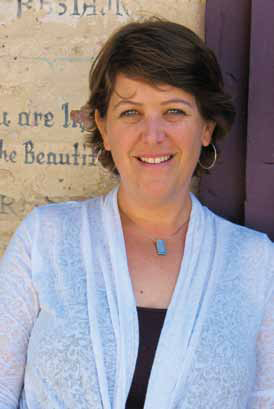Campus News
Uncommon People/Maria Streshinsky: Banana-Slug-in-chief
Award-winning magazine Miller-McCune, which focuses on groundbreaking research and innovative solutions to untenable problems, is now under the leadership of alumna Maria Streshinsky.

Miller-McCune may be the bravest, quirkiest news magazine you’ve never read.
The award-winning, Santa Barbara–based bimonthly launched in 2008, with a focus on groundbreaking research and innovative solutions to untenable problems, from e-waste to unsafe airlines to morbid obesity. The focus is on the big surprise, flipping conventional thinking.
The magazine’s just-below-the-national-radar status could change soon under the leadership of newly minted editor-in-chief Maria Streshinsky, 41 (Stevenson ‘91, comparative literature). This May, she left her managing editor post at the renowned magazine the Atlantic to lead a major re-launch of Miller-McCune.
After quickly earning a cult following among academics and pundits alike, Miller-McCune grew to a print-edition subscriber base of 100,000 (the magazine is also available free online).
Still, there is plenty of room for growth; consider the number of subscribers for two other ideas-and-issues-based magazines: 1 million for the New Yorker, and 400,000 for the Atlantic. Streshinsky hopes a publicity blast will increase Miller-McCune’s impact.
“We have a great platform,” Streshinsky said. “And we’re going to do it. We’re going to push this boulder up the hill.”
Sara Miller McCune, founder and executive chair of the magazine, said Streshinsky is just the right person to expand Miller-McCune’s presence in the national dialogue.
“Maria brings to Miller-McCune a comprehensive knowledge of the publishing industry’s best practices,” said McCune, who oversees SAGE Publications, a large publisher of academic journals, textbooks, and reference materials.
Streshinsky hopes to use social media to increase the magazine’s reach.
This makes sense, considering the highly tweetable content. In May, Miller-McCune published a modest proposal from a group of self-described “invasivores.” These eco-minded gourmands want to combat non-native invasive plants and animals by frying them up for dinner. Apparently, the voracious Indo-Pacific lionfish is delicious when rolled in pancake batter and cooked with butter and lemon juice.
The magazine, which Streshinsky describes as nonpartisan, covers legal affairs, politics, health, media, culture, and education with a blend of “think-tank” brainstorming, readability, and, in some cases, shameless entertainment.
“We don’t want it to feel like ‘eat your peas,”’ Streshinsky said. “The tone, the action, the beginning, middle, and end are all important. Is someone going to want to dig into the next piece, or are they going to feel like, ‘meh’?”
Streshinsky’s father, the late Ted Streshinksy, was an award-winning photo journalistwho covered the Berkeley free speech movement, the Black Panthers, and countercultural happenings for Time, Life, Look, and other publications. Her mother, Shirley Streshinsky, wrote “big, hard-hitting pieces” for Redbook, Glamour, and Ladies Home Journal.
Activism and public advocacy have always been part of her life. “As a little girl, I heard Joan Baez at Berkeley’s City Hall,” she said. “Moving to Santa Cruz felt like an extension of what I knew and how people acted.”
After graduating from UCSC, she became an editor at Via, AAA’s magazine, and later, a contributor and editor at Mother Jones magazine. After moving to Washington, D.C., she worked as a programs analyst in the U.S. Department of the Interior before taking the managing editor position at the Atlantic.
She put in five years there. “I loved that place, and would have stayed a lot longer” if not for her unexpected opportunity to helm Miller-McCune.
She was also eager to return to the West Coast and be closer to her family.
Streshinsky and her small crew put out their product in an historic, Spanish-style one-story building on Anacapa Street. Stepping outside, staffers can take in a view of the Santa Ynez Mountains before ducking back inside to edit stories about dangerous airlines, cyborg computers, and antipsychotic pharmaceuticals. The setting may be sleepy, but the pace is non-stop.
While the staff will use the online world to spread the word, they will hold on to their print edition.
“I love holding a magazine in my hand, carrying it around with me to the park and at the beach,” Streshinsky said. “I know you can do that with the iPad too, but I don’t care about scratching my magazine. I don’t care about getting sand in my magazine.”
This article appears in the fall 2011 issue of Review magazine.